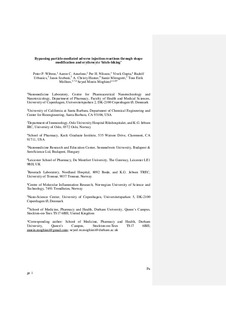| dc.contributor.author | Wibroe, Peter Popp | |
| dc.contributor.author | Anselmo, Aaron C | |
| dc.contributor.author | Nilsson, Per | |
| dc.contributor.author | Sarode, Apoorva | |
| dc.contributor.author | Gupta, Vivek | |
| dc.contributor.author | Urbanics, Rudolf | |
| dc.contributor.author | Szebeni, Janos | |
| dc.contributor.author | Hunter, Alan Christy | |
| dc.contributor.author | Mitragotri, Samir | |
| dc.contributor.author | Mollnes, Tom Eirik | |
| dc.contributor.author | Moghimi, Seyed Moein | |
| dc.date.accessioned | 2018-04-04T08:12:00Z | |
| dc.date.available | 2018-04-04T08:12:00Z | |
| dc.date.created | 2017-08-02T14:40:58Z | |
| dc.date.issued | 2017 | |
| dc.identifier.citation | Nature Nanotechnology. 2017, 12 (6), 589-594. | nb_NO |
| dc.identifier.issn | 1748-3387 | |
| dc.identifier.uri | http://hdl.handle.net/11250/2492500 | |
| dc.description.abstract | Intravenously injected nanopharmaceuticals, including PEGylated nanoparticles, induce adverse cardiopulmonary reactions in sensitive human subjects, and these reactions are highly reproducible in pigs. Although the underlying mechanisms are poorly understood, roles for both the complement system and reactive macrophages have been implicated. Here, we show the dominance and importance of robust pulmonary intravascular macrophage clearance of nanoparticles in mediating adverse cardiopulmonary distress in pigs irrespective of complement activation. Specifically, we show that delaying particle recognition by macrophages within the first few minutes of injection overcomes adverse reactions in pigs using two independent approaches. First, we changed the particle geometry from a spherical shape (which triggers cardiopulmonary distress) to either rod- or disk-shape morphology. Second, we physically adhered spheres to the surface of erythrocytes. These strategies, which are distinct from commonly leveraged stealth engineering approaches such as nanoparticle surface functionalization with poly(ethylene glycol) and/or immunological modulators, prevent robust macrophage recognition, resulting in the reduction or mitigation of adverse cardiopulmonary distress associated with nanopharmaceutical administration. | nb_NO |
| dc.language.iso | eng | nb_NO |
| dc.publisher | Nature Publishing Group | nb_NO |
| dc.title | Bypassing adverse injection reactions to nanoparticles through shape modification and attachment to erythrocytes | nb_NO |
| dc.type | Journal article | nb_NO |
| dc.description.version | submittedVersion | nb_NO |
| dc.source.pagenumber | 589-594 | nb_NO |
| dc.source.volume | 12 | nb_NO |
| dc.source.journal | Nature Nanotechnology | nb_NO |
| dc.source.issue | 6 | nb_NO |
| dc.identifier.doi | 10.1038/nnano.2017.47 | |
| dc.identifier.cristin | 1483873 | |
| dc.relation.project | Norges forskningsråd: 223255 | nb_NO |
| dc.description.localcode | This is a submitted manuscript of an article published by Nature Publishing Group in Nature Nanotechnology, 0 April 2017 | nb_NO |
| cristin.unitcode | 194,65,15,0 | |
| cristin.unitname | Institutt for klinisk og molekylær medisin | |
| cristin.ispublished | true | |
| cristin.fulltext | preprint | |
| cristin.qualitycode | 2 | |
